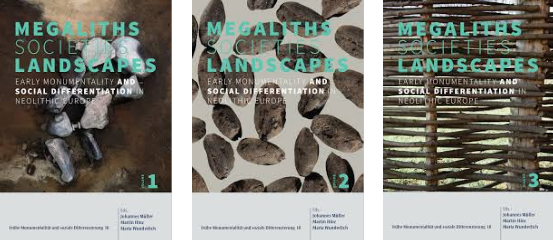- Belgique : mégalithes et cartes postales
- Carnac : une bande dessinée à caractère fantastique
- ECOSSE : Un cercle de pierre daté d'il y a 3500 ans créé de toute pièce par un fermier dans les années 90.
- Estrémadure : La sécheresse révèle une construction mégalithique vieille de 4000 ans.
- Haute-Savoie: Le dolmen de la Pierre aux Fées et le Campaniforme
- Morbihan : Ces Bretons veulent sauver leur menhir de 7 000 ans
- Mégalithisme et philatélie
- Russie : le complexe mégalithique de Vera Island
- Seine-et-Marne : retour sur une découverte mégalithique hors norme à Chamigny
- Un curieux guide des mégalithes
Europe : publications des actes du colloque mégalithique de Kiel juin 2015
04/06/2019

![]() Edités par Johannes Müller, Martin Hinz et Maria Wunderlich, les actes du colloque « Megaliths, Societies, Landscapes. Early Monumentality and Social Differentiation in Neolithic Europe » qui s’est tenu à Kiel du 16 au 20 juin 2015 viennent de sortir de presse aux éditions Habelt Verlag, à Bonn. (2019, 3 vol. Frühe Monumentalität u. soziale Differenzierung, 18, ISBN 978-3-7749-4213-4
Edités par Johannes Müller, Martin Hinz et Maria Wunderlich, les actes du colloque « Megaliths, Societies, Landscapes. Early Monumentality and Social Differentiation in Neolithic Europe » qui s’est tenu à Kiel du 16 au 20 juin 2015 viennent de sortir de presse aux éditions Habelt Verlag, à Bonn. (2019, 3 vol. Frühe Monumentalität u. soziale Differenzierung, 18, ISBN 978-3-7749-4213-4
Il s’agit de toute évidence d’un vaste travail qui constituera longtemps une référence incontournable pour tous les chercheurs impliqués dans l’étude du mégalithisme.

Ci-dessous le texte de la préface des trois éditeurs scientifiques :
« Monumentality and megaliths continue to be aprominent and central research object in prehistoric archaeology, as reflected by the lasting interest inthe research of monumentality in the course of manyresearch projects. A considerable improvement of theunderstanding of monumentality has been accomplished by improved dating-methods and comparative perspectives. In accordance with these developments, an international conference was held in Kiel in 2015, aiming to bring together researchers from all over Europe and their respective perspectives on differentforms of monumentality.The conference « Megaliths, Societies, Landscapes. Early Monumentality and Social Differentiation in Neolithic Europe » was organised by and meant as a platform for final discussions of the Priority Programme 1400 « Early Monumentality and Social Differentiation. On the origin and development of Neolithic large scale buildings and theemergence of early complex societies in Northern Central Europe ». This priority programme lasted forsix years and included several institutions in Germany. We would like to thank all of the researchers in volved for their persistent and fruitful work, which are mainly also published as monographs within this series. The European Megalithic Study Group also took part in the conference.
The conference – and with it this publication – pro-vided a framework for the presentation and discussion of many different case studies, which shed light on the interconnectedness and diversity of the complex monumentality in Neolithic and Chalcolithic Europe. It also provided a place to discuss open questions and problems, whereby we hope that this book will equally provide a basis for further discussions.
It is undoubtedly the contributions that make up the quality of these three volumes, and we are extremely grateful that so many European colleagues have been willing to contribute their knowledge to the overview of the current state of research that these books intend to provide. Indeed, it is not least thanks to the contributors’ discipline, friendliness,patience and professionalism that we have been able to compile such an extensive body of research. In advance, we had hoped that this publication could become a reference book on Early Monumentality and Social Differentiation, and if we succeed, it is thanks to every single author. Therefore, we would like to ex-press our deep gratitude.
In addition, a multitude of helping hands – in language correction, image processing and layout – make such a comprehensive publication possible in the first place, and whose work is far too rarely appreciated.These include Julia Menne, Richard Forsythe, who honed the last linguistic imperfections, Janine Cordts, Nicole Schwerdtfeger, Susanne Beyer, Agnes Heit-mann and Carsten Reckweg, who edited hundreds of illustrations and arranged them in the right places.
Without the support of the German Science Foun-dation (DFG), it would not have been possible to carry out the DFG-Priority Programme or the conference and this publication. We would like to express our sincere thanks to all these parties involved.